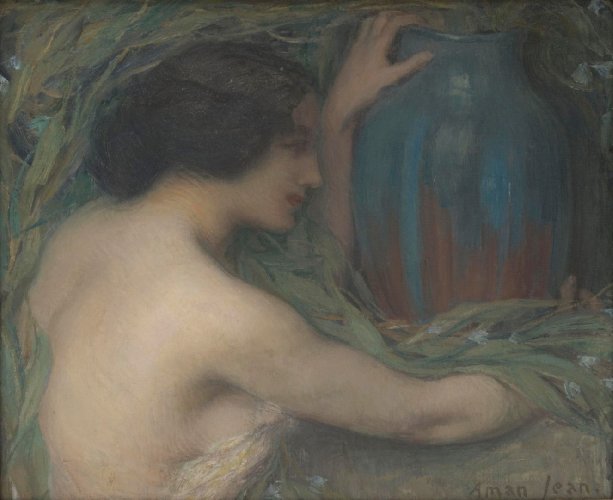Description
Armand Edmond Jean (1858-1936) was a painter and graphic artist. He studied at the École des Beaux-Arts in Paris along with his friend Seurat. Their teachers included Rudolf Lehmann and Luc-Olivier Merson. In 1885, Armand took a trip to Italy, which resulted in an enduring admiration for the country’s art. The artist met, among others, van Gogh, Mallarmé, Verlaine. He gained recognition for his mysterious female portraits depicting Parisian women, which then developed into more symbolist compositions. From 1900, the painter turned to nabiism. He exhibited at the Salon of the Société Nationale des Beaux-Arts, the Viennese Secession, or the Autumn Salon, and in 1925 participated in the Tuileries Salon, founded in 1923 with Albert Besnard, which was opposed to the academic and presented new tendencies in art.
The figure depicted in the painting is recurring in Aman-Jean’s work. The woman is identified as the artist’s children’s governess – Ella Carmikaël (Carmichael).
Description of the painting:
The artist painted a close-up of a young, dark-haired woman, her body slightly below her chest, almost naked. She supports herself with her left hand on a blue-red vase, and with her right hand she holds a bouquet of blooming eucalyptus shoots. Eucalyptus is a symbolic plant that promises longevity, peace, and protection from evil.
The evergreen shoots do not succumb to the woman’s gestures passively. They seem to be not so much placed, but to grow out of the vase standing above. They occupy almost the entire empty space of the composition, embracing the woman’s esophageal silhouette with their delicate leaves and spreading on her outstretched, resting arm on the table or cabinet. The bright green shoots of eucalyptus covered with small, pastel-colored flowers become a natural ornament, so characteristic of Art Nouveau. However, they claim to be more than just a decorative detail appearing in the background of the representation, they want to take over this representation, to surround it with their symbolic protection.


